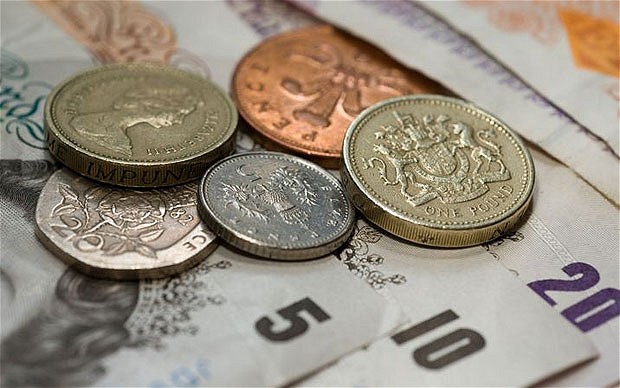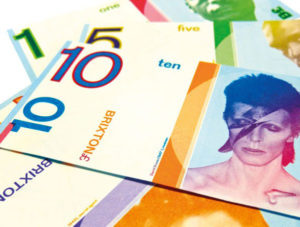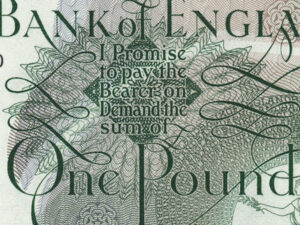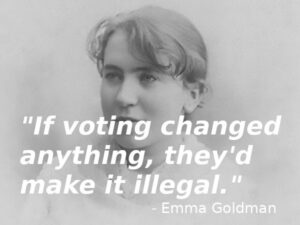Where does money really come from? (erratum: there is no fractional reserve system in the UK)

There is a simple conception of the banking system – that banks look after money for savers, and pay them interest. They then loan out that money to other people and charge them a slightly higher rate of interest, and that’s where they make their profit.
More and more people are realising that this conception is totally wrong. The new understanding that most people are coming to is that the money that banks lend doesn’t really ‘come from’ anywhere. People who work in the banking industry will explain to you about the fractional reserve system, whereby banks only have to hold around 10% of the money that they lend out. I’ve blogged about this system before. This ‘money multiplier’ model means that if someone borrows money from a bank, buys something, and the seller then deposits the money in their bank, the bank then considers it ‘real money’ (even though it’s money that has been originally borrowed from another bank), and hold 10% of it in reserve, and loan out the rest – which for a reserve ratio of 10% means that for every £100 deposited in a bank, £1000 is generated from loans – multiplying the money supply by ten.
However, it turns out that this idea is wrong too. Positive Money have been educating the public about the money system for years, and they’re telling us clearly that there is no longer a fractional reserve system in the UK. This can be checked on Wikipedia [don’t judge me for quoting Wikipedia as a source; research has shown that it’s at least as reliable as Encyclopedia Britannica – but I’ll blog more about that soon]. It seems that the trend in developed countries has been towards zero. However, on this Wikipedia page, it states that the reserve ratio in the UK is 3%. Sort it out, folks.
But there really is no longer a fractional reserve system in the UK. This means that there is no limit to the amount of money that banks can lend out – it doesn’t have to bear any relation at all to the amount of money they hold in reserve. So the only thing limiting the amount of money that banks lend is their confidence that it will be paid back.
As Steve Keen says here, before the financial crash, US official reserves were $20 billion. If the money multiplier model were correct, that would mean that the total amount of money in the US economy would have been in the region of $200 billion. But of course it wasn’t – it was trillions, because the money multiplier model doesn’t reflect reality.
This is how the modern money system works – first watch this video from Positive Money, and I’ll summarise below.
- So, most spending involves money being shifted around between bank accounts – when we pay by card or bank transfer. At the end of each day, there’s not much difference between the amounts of money shifted into accounts at Barclays, Lloyds or NatWest. Tiny transfers can balance everything out, with hardly anything needed to be held in reserve. The only time substantial reserves would be required is if everyone came for their money at once – but that would only happen if all confidence had been lost, and would almost definitely signal the end of the bank (cf Northern Rock).
- You’d think that standard accounting would expose or even prevent banks from creating money from nothing. The way this is avoided is by adding new loans to the bank’s assets column on the balance sheet (because the loan is money that the customer owes to the bank, and is therefore an asset); but at the same time, it’s also added to the liabilities column (because the money is created in the customer’s deposit account, and is therefore money that the bank promises to provide to the customer, and is therefore a liability). These two entries cancel each other out, and to all intents and purposes, it appears that nothing has happened. But something has happened – there is more money in the economy, that can be spent on real things.
The implications of this are:
- most money is imaginary: all the goods and services in the world could be bought by a tiny fraction of the amount of ‘money’ that exists, so all the money in the world can’t possibly be spent, because there isn’t enough real ‘stuff’ – in terms of products and services – to spend it on.
- private banks control the money supply, not governments or central banks.
- in boom times, there is no mechanism to control the amount of money that banks can create by issuing loans, so there was nothing to stop the sub-prime nightmare that caused the 2008 crash.
The internet is now awash with blogs by economists who are trying to point out that allowing banks to control the money supply is fine, spinning tales that try to make the reader believe that:
- perpetual growth is possible
- orienting the entire economies of countries towards exports is a good idea, rather than producing things for our communities
- the current system doesn’t destroy the biosphere, and
- doesn’t prevent democracy, and
- isn’t exploitative
- the risk of 2008 happening again is low
- having millions of people lose their homes, and having all taxpayers bail out corporate banks is a price worth paying to keep this system
They were more than happy to keep quiet before, but now that the cat’s out of the bag, they feel the need to justify this rotten system, because their discipline is nonsensical without it.
The views expressed in our blog are those of the author and not necessarily lowimpact.org's
5 Comments
-
1alex tutus February 5th, 2023
My life has changed the last couple months. I have learnt a lot about money I never knew existed. The reason I’ve learn this all? I’ve been focused. On making it. On becoming something. And I will. Anyway, I told myself, let’s take it a step back. What is it I want? “Money.” What is money? “A currency, a store of value.” Why do I want that? “… I don’t know.” Exactly. So I started learning. And I’ve ended up here. I knew about fractional reserve banking prior to this blog. But not in this light. And now it all makes sense. Money really is not f****ing real. I want the writer to this page to know, I appreciate your viewpoint, and I appreciate it being spread on the web like this. Thank you for the knowledge, you’ve aided me today.
-
2Rebecca Stacey February 5th, 2023
Thanks for this comment – this is exactly what we are trying to do! I hope you keep reading and get involved!
-
3M June 6th, 2023
I'm pretty sure this is wrong. If you go on the Bank of England website it says that they need a minimum of 12% reserve ratio:
https://www.bankofengland.co.uk/-/media/boe/files/quarterly-bulletin/1971/reserve-ratios-further-definitions.pdf
-
4Matthew Slater June 8th, 2023
M, that BofE document you linked to is 1971.
IN 2020 the Federal Reserve dropped reserve requirements for most types of banks.
I'm unaware of how much other countries followed, but that just illustrates how different the regulatory landscape is now.
-
5Naif Choudhury June 14th, 2023
The bank of england actually admits in their own documentation that they do not operate under a fractional reserve banking system. I found this during a paper I wrote at undergraduate level, it was an official recent pdf on their website and even on a specific website page about how their banking works.
My take is that, every security or asset a bank has; is bet on to be worth a certain value. If it isn't, it's word out, if it is, it's calculated how much it grows and that growth is used to determine the new worth of a currency altogether.
Something like that.




 The discipline of economics presupposes corporate capitalism and perpetual growth, which renders it invalid
The discipline of economics presupposes corporate capitalism and perpetual growth, which renders it invalid
 Where does money come from? A bit of history
Where does money come from? A bit of history
 What’s the relative value of the world’s gold, Bitcoins, banknotes, derivatives, stocks & shares, property etc. See this incredible visualisation
What’s the relative value of the world’s gold, Bitcoins, banknotes, derivatives, stocks & shares, property etc. See this incredible visualisation
 This is the best attempt I’ve seen at building a sustainable, democratic, (and inevitably moneyless) economy. It’s worth understanding what they’re saying
This is the best attempt I’ve seen at building a sustainable, democratic, (and inevitably moneyless) economy. It’s worth understanding what they’re saying
 Local / independent currencies
Local / independent currencies
 Low-impact money
Low-impact money
 The 'democracy problem'
The 'democracy problem'


